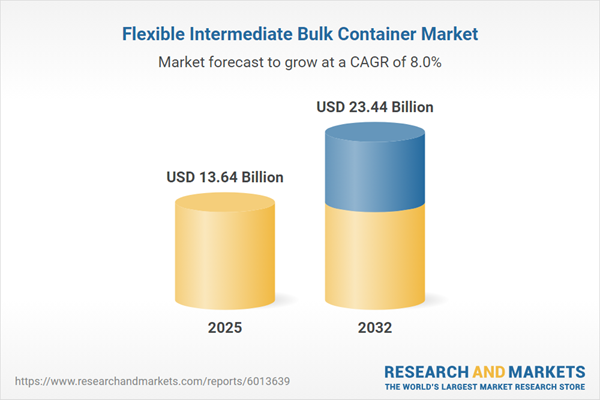Speak directly to the analyst to clarify any post sales queries you may have.
The flexible intermediate bulk container market is rapidly evolving, shaped by changing industry demands, supply chain innovation, and a growing focus on sustainability. Decision-makers navigating this landscape must understand how advancements in container technology and global trade policies are influencing competitive strategies.
Market Snapshot: Flexible Intermediate Bulk Container Market
The Flexible Intermediate Bulk Container (FIBC) Market grew from USD 12.67 billion in 2024 to USD 13.64 billion in 2025 and is projected to continue expanding at a CAGR of 7.99%, reaching USD 23.44 billion by 2032. Robust adoption across industries such as agriculture, chemicals, construction, food and beverages, mining, metals, and plastics reflects rising demand for efficient and customizable packaging. Industry stakeholders are responding to regulatory changes, advances in materials science, and digitalization, ensuring the FIBC sector’s adaptability and strategic value.
Scope & Segmentation
- Capacity Segments: Options for less than 500 kg, 500 to 1000 kg, and over 1000 kg serve everything from high-value batches to large-scale commodity logistics.
- Material Types: Use of polyethylene for affordability and flexibility and polypropylene for enhanced strength and chemical resilience underpins material choice.
- Distribution Channels: Direct sales cater to large industrial accounts seeking custom solutions, while retail sales offer standardized options suited to small enterprises and fast delivery needs.
- Applications: Packaging and transportation containers with reinforced features address bulk handling demands, while storage containers prioritize moisture and static protection.
- End-Use Industries: Agriculture, chemicals and pharmaceuticals, construction, food and beverages, mining and metals, as well as plastics and rubber, influence specific container design and performance requirements.
- Regional Coverage: Americas (U.S., Canada, Mexico, Brazil, Argentina, Chile, Colombia, Peru), Europe, Middle East & Africa (including the UK, Germany, France, Russia, UAE, South Africa, Nigeria, Kenya), and Asia-Pacific (China, India, Japan, Australia, and more).
- Technology Trends: Adoption of RFID tagging, blockchain data records, advanced polymer blends, and modular product designs for increased lifecycle performance and durability.
Key Takeaways for Senior Decision-Makers
- Strong global demand is driven by interlinked supply chains and the need for scalable, standardized, and customizable bulk container solutions.
- Material innovation, with the rise of lighter, durable polymers and recycled blends, supports efficiency and aligns with environmental goals.
- Digitalization—through inventory tracking, compliance monitoring, and supply chain analytics—is elevating operational control and transparency.
- Adapting to regional regulatory landscapes and shifting global trade flows is crucial for maintaining competitiveness and managing risk exposure.
- Integrated service offerings—ranging from design consultation to post-deployment monitoring—differentiate providers in an increasingly value-oriented market.
Tariff Impact and Competitive Dynamics
Recent tariff adjustments in the United States have significant implications for FIBC supply chains and sourcing strategies. Firms with overseas production operations are reevaluating locations and supplier relationships to mitigate higher landing costs. This has accelerated moves toward localized manufacturing, while competitors in unaffected regions are leveraging cost advantages to capture greater market share. Strategies such as multi-sourcing, contract renegotiations, and dynamic pricing are being adopted to offset persistent volatility.
Methodology & Data Sources
This report’s findings are grounded in primary interviews with industry executives, procurement leaders, and supply chain specialists, complemented by broad-based stakeholder surveys. Secondary data was sourced from technical journals, trade publications, and official reports, with all quantitative insights verified against expert panel reviews to ensure accuracy and depth.
Why This Report Matters
- Delivers actionable intelligence on material, application, and capacity trends to support strategic procurement and investment decisions.
- Unpacks global and regional regulatory developments and tariff impacts for proactive operational planning and risk management.
- Reveals evolving technology adoption and supplier innovation that can drive efficiency and sustainable growth in the flexible intermediate bulk container sector.
Conclusion
Senior leaders leveraging this report will gain a multi-faceted view of the flexible intermediate bulk container market, from segmentation detail to technology shifts and regional strategy. These insights empower data-driven decision-making and stronger competitive positioning as the industry continues to evolve.
Additional Product Information:
- Purchase of this report includes 1 year online access with quarterly updates.
- This report can be updated on request. Please contact our Customer Experience team using the Ask a Question widget on our website.
Table of Contents
3. Executive Summary
4. Market Overview
7. Cumulative Impact of Artificial Intelligence 2025
Companies Mentioned
The companies profiled in this Flexible Intermediate Bulk Container market report include:- Ameriglobe LLC
- Berry Global Group, Inc.
- Bulk Corp International
- Commercial Syn Bags Ltd.
- Halsted Corporation
- Hebei FIBC Manufacturing Co.
- Intertape Polymer Group Inc.
- LC Packaging International BV
- Mauser Packaging Solutions
- Minibulk Inc.
- Mondi PLC
- Packem Umasree Private Limited
- Palmetto Industries International Inc.
- Pyramid Technoplast Ltd.
- Rapid Packaging
- RDA Bulk Packaging Ltd.
- RDB Rasayans Limited
- Rishi FIBC Solutions Pvt Ltd.
- Schütz GmbH & Co. KGaA
- SIA Flexitanks Limited
- Sonoco Products Company
- Super Sack Bag, Inc.
- Taihua Group
- The International Paper Company
- Yixing City Changfeng bulk bag Co.
Table Information
| Report Attribute | Details |
|---|---|
| No. of Pages | 181 |
| Published | November 2025 |
| Forecast Period | 2025 - 2032 |
| Estimated Market Value ( USD | $ 13.64 Billion |
| Forecasted Market Value ( USD | $ 23.44 Billion |
| Compound Annual Growth Rate | 7.9% |
| Regions Covered | Global |
| No. of Companies Mentioned | 26 |









